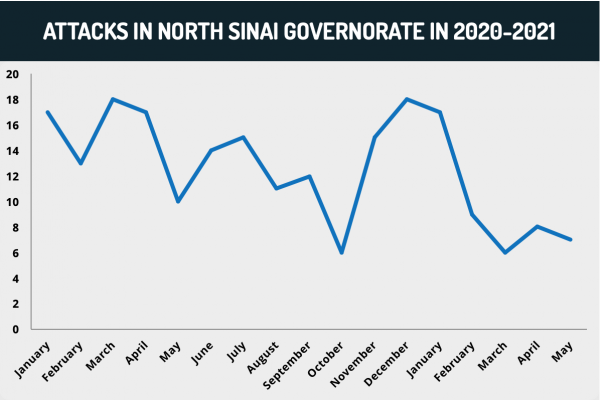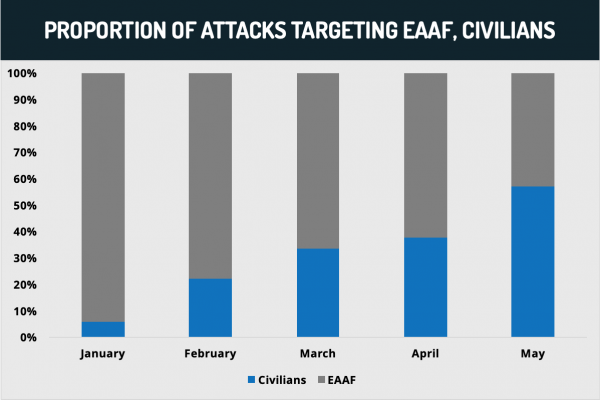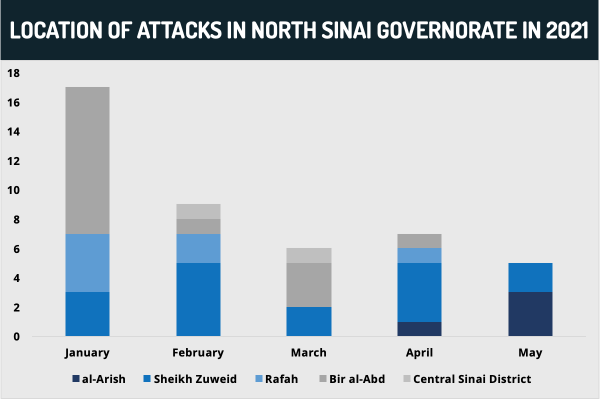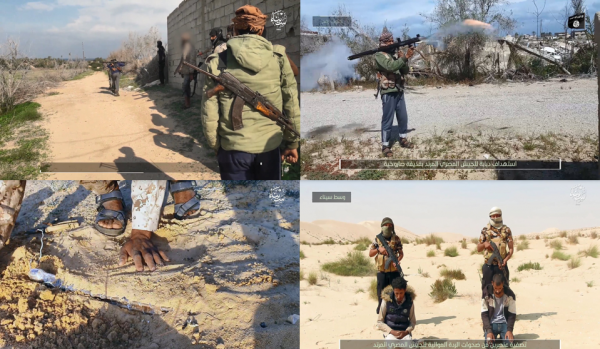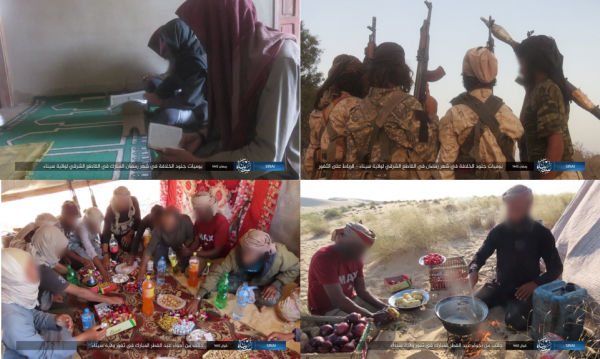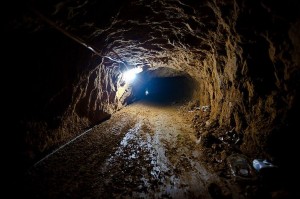Executive Summary
- There has been a gradual decrease in the number of attacks conducted by Islamic State (IS)-affiliated Wilayat Sinai in the North Sinai Governorate in 2021. This indicates that the Sunni jihadist militant group is coming under increasing pressure, both in terms of its ranks and capabilities.
- There has been a gradual shift in Wilayat Sinai’s targeting of local Bedouin tribesmen perceived to be collaborating with the Egyptian Armed Forces (EAAF) in North Sinai in 2021. This is liable to further alienate the local population and diminish the militant group’s recruitment base.
- As Wilayat Sinai comes under increasing pressure, it will attempt to regroup and may launch a symbolic attack in the region in order to garner media attention and project that it still poses a major threat to Egypt. Such an attack could either be more sophisticated in terms of its planning and execution or it could be relatively small-scale but attack a target of a higher value.
- The anticipated decrease in threat of militancy in the North Sinai Governorate will allow the Egyptian government to redeploy troops to mainland Egypt and project President Abdel Fatah al-Sisi’s policies as effective. Sisi will use this to gain international recognition of his legitimacy as the ruler of Egypt, especially considering recent concerns regarding human rights in the country.
- Avoid all travel to the North Sinai Governorate due to the persistent risk of militancy, kidnappings, and general lawlessness in the region. If conducting essential business in the region, it is advised to travel in armored vehicles with trained security personnel.
Latest Trends
- There has been a gradual decrease in the number of attacks conducted by Islamic State (IS)-affiliated Wilayat Sinai in the North Sinai Governorate in 2021. The militant group conducted 17 attacks in January, nine in February, six in March, eight in April, and seven in May. In contrast, in 2020 between ten and 18 attacks were recorded per month, with the exception of October when only six attacks occurred.
- There has been a gradual increase in Wilayat Sinai’s focus of operations targeting local Bedouin tribesmen perceived to be collaborating with the Egyptian Armed Forces (EAAF) in the North Sinai Governorate in 2021, at the expense of attacks against the EAAF itself. About six percent of attacks in January targeted such individuals, followed by about 22 percent in February, 33 percent in March, 38 percent in April, and 57 percent in May.
- There was a slight uptick in attacks around al-Arish beginning from the end of April up until the end of May. Wilayat Sinai conducted no attacks in the al-Arish area between January and March. One attack was recorded near the al-Arish Airport, located south of al-Arish, on April 30. This was followed by three attacks in areas located either west or east of al-Arish in May. These attacks took place at the expense of other Wilayat Sinai strongholds, primarily Bir al-Abd and Rafah.
Notable IS Media Publications
- On January 9, IS released a video that started off by deriding the Egyptian government for its inability to defeat Wilayat Sinai in the North Sinai Governorate. The rest of the video focused on three main themes: IED and sniper attacks, locally-made weapons, and the kidnapping and execution of EAAF soldiers and their collaborators.
- On April 18, IS released a 13-minute long video titled, “Epic Makers 2”. The video depicted the militants carrying locally-made shoulder-launched electrically-fired rockets as well as planting pressure-plate IEDs along roads in the North Sinai Governorate. Most notably, it depicted the execution of civilian prisoners, two of whom belonged to a local tribe and were abducted on Central Sinai District’s Mount Maghara in February. One of the victims was a Coptic Christian who was abducted from Bir al-Abd in November 2020.
- IS released three series of photographs between May 4-15 that depicted Wilayat Sinai militants during the Ramadan and Eid al-Fitr period. The photographs showcased the militants engaged in prayers as well as preparing and partaking meals in a camp in an open desert area in the North Sinai Governorate in broad daylight. One set of photographs also showed militants carrying automatic weapons and RPGs.
- The IS-linked media agency also released several other photographs over the course of March and April which depicted the execution of local Bedouin tribesmen, primarily from the Maghara and Tarabin tribes, in the North Sinai Governorate for collaborating with the EAAF.
Assessments & Forecast
Wilayat Sinai’s declining ranks, capabilities in North Sinai Governorate to prompt it to conduct more symbolic attacks to raise morale of fighters, attract support
The overall trend of a gradual decrease in Wilayat Sinai-perpetrated attacks in the North Sinai Governorate in 2021 indicates that the Sunni jihadist militant group is coming under increasing pressure in the region, both in terms of its ranks and capabilities. This is underscored by several factors:
- The majority of Wilayat Sinai attacks in the North Sinai Governorate have primarily involved the use of roadside IEDs and sniper fire. This type of modus operandi allows Wilayat Sinai to inflict casualties upon targets without engaging in direct confrontations, thus reducing the risk of losing its own fighters and weaponry during battle. This indicates that Wilayat Sinai’s ranks are likely currently limited and, therefore, while it wants to maintain the pace of its attacks, it cannot afford to suffer losses to its personnel.
- Wilayat Sinai’s recent shift in its focus of operations away from the EAAF and towards local Bedouin tribesmen indicates that the group is prioritizing softer targets as this increases the possibility of success of their attacks without unnecessarily risking their fighters’ lives. Such attacks also serve to deter cooperation between local Bedouin tribesmen and the EAAF, thus diminishing the effectiveness of the latter’s counter-militancy campaign.
- The time lag between Wilayat Sinai attacks and the date of release of IS claims has been increasing in recent weeks and months. The most prominent example of this is the IS claim that was released on May 6, in which IS took responsibility for large-scale clashes with the EAAF in El Gorah, located south of Sheikh Zuweid, over a three-day period between April 29-May 1. In the past, the militant group used to almost immediately release claims for its attacks in the North Sinai Governorate, sometimes even within hours of the attack itself. This indicates that Wilayat Sinai militants may be deliberately refraining from using electronic communication devices immediately following an attack as this makes them vulnerable to detection by the EAAF through the use of signals intelligence (SIGINT) techniques. This is likely part of an overall effort to maintain a low profile in order to avoid detection by security forces and preserve its ranks.
- A report from an independent local media outlet indicates that the Egyptian government launched an initiative towards the end of 2020 according to which it would grant amnesty to militants who turned themselves into the EAAF, although they would be subject to extensive interrogation by security forces. This reportedly prompted a significant number of militants to voluntarily surrender in December 2020. This was partially corroborated by the EAAF Spokesperson on March 9, when he released a video titled, “Sirat Shaheed”, which featured confessions of three Wilayat Sinai militants who surrendered to security forces in Sheikh Zuweid and Rafah after they found themselves besieged by the EAAF and short on food. If confirmed, this policy would also partially explain the significant downtick in Wilayat Sinai attacks in the North Sinai Governorate in 2021 as compared to 2020.
- Wilayat Sinai was once known to be in possession of more sophisticated weaponry, including Kornet anti-tank guided missiles (ATGMs) and man-portable air defense systems (MANPADs). Therefore, the fact that the militant group focused its April 18 video on locally-made shoulder-launched electrically-fired rockets indicates that the group is facing supply line constraints, which is compelling it to become increasingly reliant on modifications of existing weaponry. While this shows that at least some of the militants within the group’s ranks have a high knowledge and technical expertise of weapons systems, it is indicative of the current pressure on the group in terms of rebuilding its capabilities. This is further underscored by the fact that Wilayat Sinai has recently not conducted any attacks using relatively sophisticated modi operandi, such as vehicle-borne IEDs (VBIEDs), which were once commonly used by the militant group in the region. Moreover, the last claimed use of an ATGM by the group was in December 2017, when the group targeted a helicopter at the al-Arish Airport. This may indicate that Wilayat Sinai is either no longer in possession of such weapons or that it does not have fighters who have the technical capabilities to use such sophisticated weaponry. The militants could also be saving their limited arsenal of such weapons for future attacks against more high-profile targets.
Increasing focus of attacks against civilians to further alienate local Bedouin tribes, reduce Wilayat Sinai’s base of recruitment
- The trend of an increase in the focus of operations against civilians perceived to be cooperating with the EAAF is not only based on Wilayat Sinai’s local operating constraints but is also part of a larger strategy of intimidating the local population of the North Sinai Governorate. This is because the increasing collaboration between the EAAF and local Bedouin tribesmen, primarily those from the Tarabin and Maghara tribes, has likely diminished Wilayat Sinai’s ability to operate freely in the region. Local Bedouin tribesmen are more familiar with the local terrain and population of the North Sinai Governorate and thus likely provide valuable information to the EAAF regarding the location of militant hideouts in the region.
- Furthermore, some of these tribesmen are actively engaged in counter-militancy operations along with the EAAF, which has led to major losses within the militant group’s ranks. For example, on March 21, the Sinai Tribal Federation, which is a group of local Sinai tribesmen involved in anti-IS operations, reported that it had killed a local Wilayat Sinai Emir in a joint operation with the EAAF in an unspecified area of the North Sinai Governorate. Therefore, through its attacks against such local tribesmen, Wilayat Sinai aims to deter locals from cooperating with the authorities by conveying the message that this would make them legitimate targets for attacks. This threat carries some weight as the militant group does not indiscriminately target civilians in the North Sinai Governorate.
- This assessment is supported by the fact that almost all of IS’s publications that have been released since the beginning of 2021 have focused on the kidnapping and execution of tribesmen working against the militant group. Aside from this, almost every time that IS has released a claim of responsibility for killing a civilian in recent months, it has released pictures depicting the execution itself. This is meant to create a strong psychological impact upon the local population of the region and bolster Wilayat Sinai’s message.
- FORECAST: However, based on precedent, this strategy is likely to backfire as it will further turn the local population against Wilayat Sinai and increase their determination to completely dislodge the militant group from the region. This is also because the decade-long militant campaign, which started off as a local insurgency in 2011, has led to wide-scale destruction of infrastructure and private property in the North Sinai Governorate. The EAAF’s consequent counter-militancy campaign to secure the region has severely restricted the locals’ civil liberties and freedom of movement, which has negatively impacted their livelihoods and standards of living. For instance, up until mid-March 2021, the city of Sheikh Zuweid had reportedly been under a complete lockdown since July 2015 with fortified army checkpoints that controlled all movement.
- FORECAST: As more and more tribesmen join the EAAF in its counter-militancy campaign, Wilayat Sinai’s ability to operate within the North Sinai Governorate will diminish significantly. This will reduce the group’s profile, and with it, its ability to attract recruits from among the local population. Locals who may be sympathetic towards the militant group may also be deterred from lending support to it as this could put them at risk of detention by security forces. A decline in Wilayat Sinai’s image may also incentivize demoralized militants to voluntarily turn themselves in to the authorities under the reported amnesty program. This would trigger a vicious cycle by impacting Wilayat Sinai’s overall capabilities and ability to recruit fighters.
- That said, Wilayat Sinai has shown the ability to adapt to the changing security landscape of the North Sinai Governorate on several occasions in the past few years. FORECAST: Therefore, the militant group is unlikely to completely cease to exist in the coming months. It is more likely to reduce the pace of its attacks in certain areas during certain periods to maintain a low profile, which would allow it to regroup and resume its activity at a time when the security environment is more favorable. This strategy is underscored by the significant decline in Wilayat Sinai attacks in the Bir al-Abd area from January to May. Bir al-Abd had become one of Wilayat Sinai’s primary areas of operations towards the second half of 2020. Between January and May 2021, the militant group shifted its operations slightly eastward towards al-Arish, possibly to increase the EAAF’s perception of the threat of militancy in this area and compel it to divert resources away from Bir al-Abd. This would relieve some of the pressure on Wilayat Sinai’s fighters in Bir al-Abd and allow them to regroup. Overall, Wilayat Sinai’s ability to evolve according to the dynamic security environment of the North Sinai Governorate will enable it to remain entrenched in the region in the coming months.
Wilayat Sinai likely to attempt to launch symbolic attack in North Sinai Governorate in coming months to project it still poses threat to Egypt
- As Wilayat Sinai continues to come under increasing pressure in the North Sinai Governorate, it will attempt to regroup and possibly launch a symbolic attack in the region in order to garner media attention and project that it still poses a major threat to Egypt. This would be partly motivated by an effort to elevate the morale of its remaining fighters and possibly even attract some support and recruits from among the more disenfranchised segments of the local population of the Sinai Peninsula.
- FORECAST: Such an attack could either be more sophisticated in terms of its planning and execution so as to inflict high casualties among the target or it could be relatively small-scale but target something of a higher value, such as an oil pipeline. Wilayat Sinai has attempted both types of attacks from time to time. For example, the militant group recently claimed large-scale clashes with the EAAF in El Gorah, located south of Sheikh Zuweid, over a period of three days between April 29-May 1. Although the exact number of EAAF casualties remains unspecified, IS claimed that several EAAF soldiers were killed and wounded and four EAAF vehicles were destroyed in the attack. IS also claimed IED detonations against oil pipelines near al-Arish on three separate occasions in 2020 (February, November, December). These attacks did not cause extensive damage to the pipelines but were symbolic as they underscored the threat to strategic infrastructure in the North Sinai Governorate. Nevertheless, such attacks are liable to remain infrequent and become increasingly rare over the coming months as the militant group will be constrained by its declining ranks and capabilities.
- FORECAST: Wilayat Sinai may also attempt to conduct attacks in areas located on the western edges of the North Sinai Governorate. This is because an attack in this region would garner major media attention for the militant group due to the proximity of the Suez Canal. Although the militant group does not maintain a significant operational presence on the northwestern edges of the Sinai Peninsula, it has in the past demonstrated some ability to infiltrate this region. For instance, on December 13, 2020, IS released footage showcasing the execution of an alleged army “spy” in Sahl al-Tina, located approximately 35 km southeast of Port Said and about 25 km east of the Suez Canal. Prior to that, security forces arrested armed Wilayat Sinai militants in Gelbana on three occasions in 2019-20 (September 2019, June 2020, October 2020). Gelbana is administratively part of Ismailia Governorate but is geographically within the Sinai Peninsula and is located only about 12 km east of the Suez Canal. While Wilayat Sinai currently does not have the capabilities to launch a large-scale attack in areas located close to the Suez Canal as these are heavily fortified by the EAAF, even a small-scale attack of low sophistication in this region, such as the one in Sahl al-Tina, would be symbolic enough to raise the militant group’s profile. Therefore, as Wilayat Sinai’s overall capabilities in the North Sinai Governorate diminishes and the group becomes more desperate to preserve its image, the underlying risk of militancy in areas near the Suez Canal may increase slightly.
- FORECAST: The changing trends in jihadist militancy in the North Sinai Governorate are unlikely to have any impact upon the security environment in mainland Egypt. This is because while IS may maintain some sleeper cells in mainland Egypt, the capabilities of its fighters in this region have been significantly depleted as a result of the success of the Egyptian security forces’ years-long counter-militancy campaign. This is underscored by the fact that IS has not even attempted to conduct an attack in mainland Egypt since February 2019. Moreover, there have been no reported indications of attempts by IS to regroup and reestablish its operational presence in mainland Egypt over the past two years. However, this does not indicate that the underlying risk of IS militancy in mainland Egypt has been completely eradicated. It rather suggests that IS’s ability to operate in mainland Egypt is bound by the operational constraints of capabilities within the security environment of the region, especially considering that Wilayat Sinai has shown no interest in expanding its operations to areas beyond the Sinai Peninsula since its inception.
Anticipated decrease in threat of militancy to allow government to redeploy troops to mainland Egypt, project President Abdel Fatah al-Sisi’s policies as effective
- The Egyptian government has heavily invested in its counter-militancy campaign in the North Sinai Governorate over the past five to six years. This investment increased drastically upon the launch of Operation Martyrs’ Right in 2015. The fourth phase of this operation, which was launched in mid-2017, was the most extensive. It included the creation of a buffer zone along the Sinai-Gaza border, deployment of combat troops to Egypt’s borders with Libya and Sudan, deployment of naval assets to the Mediterranean Sea north of the Sinai Peninsula, and an increase in security protocols along the Shahid Ahmed al-Hamdi tunnel that links mainland Egypt to the Sinai Peninsula. This was aside from the counter-militancy measures undertaken within the North Sinai Governorate. With the launch of Operation Sinai 2018 in February 2018, the Egyptian government further increased its investment in the counter-militancy campaign in the North Sinai Governorate by authorizing the EAAF to engage in construction and development projects in the region. While the Executive Sinai Reconstruction Agency is the main authority responsible for overseeing development projects in the Sinai Peninsula, the EAAF is also known to either have a stake in or completely own several construction companies engaged in development projects in the country.
- FORECAST: With a decrease in the threat of militancy in the North Sinai Governorate, the Egyptian government will be able to at least partially redeploy forces from the Sinai Peninsula to mainland Egypt. This will also allow the government to invest some of the resources that had earlier gone into its counter-militancy campaign towards the redevelopment of the North Sinai Governorate. The Egyptian government has already reportedly allocated 275 billion Egyptian pounds (approximately 15.3 billion USD) towards development projects in the Sinai Peninsula until 2022. This includes road expansion projects in al-Arish and Sheikh Zuweid to improve transport connectivity between mainland Egypt and the Sinai Peninsula.
- FORECAST: A decline in the risk of militancy in the North Sinai Governorate will moreover allow President al-Sisi to project himself and his administration to the domestic populace as well as all international stakeholders as the only viable option for a safe and secure Egypt. Sisi will likely capitalize upon this to reinforce his position as an important Western ally in the fight against jihadist militancy in the Middle East and North Africa in order to gain access to advanced military technology, as he has often done in the past. He will also use this to gain international recognition of his legitimacy as the ruler of Egypt. This is especially considering recent concerns among Cairo’s Western allies, primarily the US, regarding the poor human rights record of the al-Sisi-led administration. This will allow the current Egyptian administration to continue to clamp down on opposition activists and political leaders in the country under the guise of national security without the risk of any major international censure. The government’s strict control over both social media platforms and local traditional media outlets will allow it to censor any criticism of its policies, particularly those pertaining to civil liberties, and thus control the narrative presented to the international community.
Recommendations
- Travel to Cairo and Alexandria may continue while adhering to all security precautions regarding militancy and civil unrest. Contact us at [email protected] or +44 20-3540-0434 for itinerary and contingency support options.
- Avoid all travel to the North Sinai Governorate due to the persistent risk of militancy, kidnappings, and general lawlessness in the region. If conducting essential business in the region, it is advised to travel in armored vehicles with trained security personnel. Furthermore, take prior permission from the Egyptian authorities as several parts of the governorate are currently under complete lockdown.
- It is advised to keep identification and travel documents on your person at all times due to the prevalence of military checkpoints across the North Sinai Governorate. When coming in contact with a security checkpoint, comply with the instructions of security personnel and avoid behavior that may be viewed as threatening. Photographing military sites and checkpoints is prohibited and may lead to arrest.
- As a general security precaution, remain vigilant in areas surrounding and avoid the immediate vicinity of government and other strategic energy installations, police stations, and religious centers, particularly churches, as these locations remain under elevated threat of militant attacks. When traveling in central squares or in areas with persistent police deployments, avoid the immediate vicinity of security forces, particularly fixed traffic booths, as such personnel and facilities have come under attack by militants.
- Avoid making any statements critical of President Abdel Fatah al-Sisi, government policies, and ongoing trials as legal measures, including deportation and detention, have been taken regardless of nationality. This applies both to public spaces and online social media platforms.

